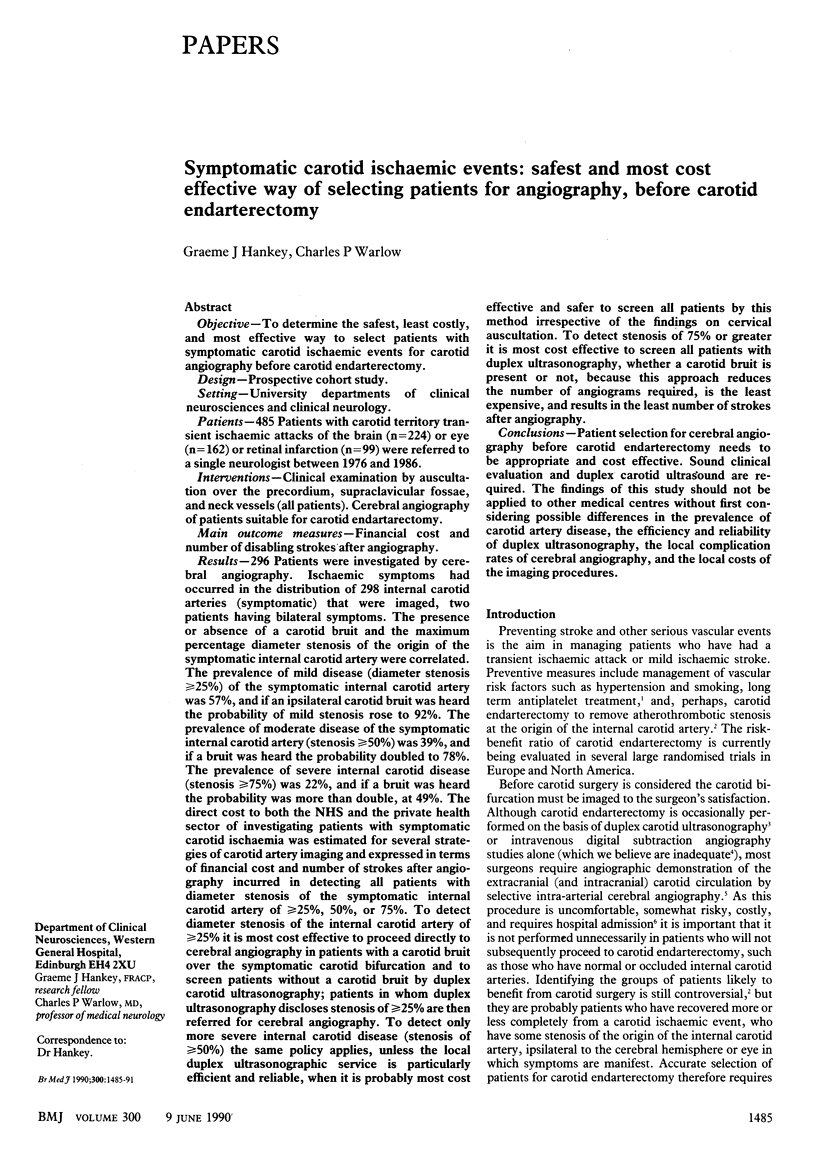Abstract
OBJECTIVE: To determine the safest, least costly, and most effective way to select patients with symptomatic carotid ischaemic events for carotid angiography before carotid endarterectomy. DESIGN: Prospective cohort study. SETTING: University departments of clinical neurosciences and clinical neurology. PATIENTS: 485 Patients with carotid territory transient ischaemic attacks of the brain (n = 224) or eye (n = 162) or retinal infarction (n = 99) were referred to a single neurologist between 1976 and 1986. INTERVENTIONS: Clinical examination by auscultation over the precordium, supraclavicular fossae, and neck vessels (all patients). Cerebral angiography of patients suitable for carotid endarterectomy. MAIN OUTCOME MEASURES: Financial cost and number of disabling strokes after angiography. RESULTS: 296 Patients were investigated by cerebral angiography. Ischaemic symptoms had occurred in the distribution of 298 internal carotid arteries (symptomatic) that were imaged, two patients having bilateral symptoms. The presence or absence of a carotid bruit and the maximum percentage diameter stenosis of the origin of the symptomatic internal carotid artery were correlated. The prevalence of mild disease (diameter stenosis greater than or equal to 25%) of the symptomatic internal carotid artery was 57%, and if an ipsilateral carotid bruit was heard the probability of mild stenosis rose to 92%. The prevalence of moderate disease of the symptomatic internal carotid artery (stenosis greater than or equal to 50%) was 39%, and if a bruit was heard the probability doubled to 78%. The prevalence of severe internal carotid disease (stenosis greater than or equal to 75%) was 22%, and if a bruit was heard the probability was more than double, at 49%. The direct cost to both the NHS and the private health sector of investigating patients with symptomatic carotid ischaemia was estimated for several strategies of carotid artery imaging and expressed in terms of financial cost and number of strokes after angiography incurred in detecting all patients with diameter stenosis of the symptomatic internal carotid artery of greater than or equal to 25%, 50%, or 75%. To detect diameter stenosis of the internal carotid artery of greater than or equal to 25% it is most cost effective to proceed directly to cerebral angiography in patients with a carotid bruit over the symptomatic carotid bifurcation and to screen patients without a carotid bruit by duplex carotid ultrasonography; patients in whom duplex ultrasonography discloses stenosis of greater than or equal to 25% are then referred for cerebral angiography. To detect only more severe internal carotid disease (stenosis of greater than or equal to 50%) the same policy applies, unless the local duplex ultrasonographic service is particularly efficient and reliable, when it is probably most cost effective and safer to screen all patients by this method irrespective of the findings on cervical auscultation. To detect stenosis of 75% or greater it is most cost effective to screen all patients with duplex ultrasonography, whether a carotid bruit is present or not, because this approach reduces the number of angiograms required, is the least expensive, and results in the least number of strokes after angiography. CONCLUSIONS: Patients selection for cerebral angiography before carotid endarterectomy needs to be appropriate and cost effective. Sound clinical evaluation and duplex carotid ultrasound are required. The findings of this study should not be applied to other medical centres without first considering possible differences in the prevalence of carotid artery disease, the efficiency and reliability of duplex ultrasonography, the local complication rates of cerebral angiography, and the local costs of the imaging procedures.
Full text
PDF






Selected References
These references are in PubMed. This may not be the complete list of references from this article.
- Chambers B. R., Norris J. W. Clinical significance of asymptomatic neck bruits. Neurology. 1985 May;35(5):742–745. doi: 10.1212/wnl.35.5.742. [DOI] [PubMed] [Google Scholar]
- Chambers B. R., Norris J. W. Outcome in patients with asymptomatic neck bruits. N Engl J Med. 1986 Oct 2;315(14):860–865. doi: 10.1056/NEJM198610023151404. [DOI] [PubMed] [Google Scholar]
- David T. E., Humphries A. W., Young J. R., Beven E. G. A correlation of neck bruits and arteriosclerotic carotid arteries. Arch Surg. 1973 Nov;107(5):729–731. doi: 10.1001/archsurg.1973.01350230081016. [DOI] [PubMed] [Google Scholar]
- DeWeese J. A., Rob C. G., Satran R., Norris F. H., Lipchik E. O., Zehl D. N., Long J. M. Surgical treatment for occlusive disease of the carotid artery. Ann Surg. 1968 Jul;168(1):85–94. doi: 10.1097/00000658-196807000-00010. [DOI] [PMC free article] [PubMed] [Google Scholar]
- Finkler S. A. The distinction between cost and charges. Ann Intern Med. 1982 Jan;96(1):102–109. doi: 10.7326/0003-4819-96-1-102. [DOI] [PubMed] [Google Scholar]
- Gautier J. C., Rosa A., Lhermitte F. Auscultation carotidienne. Corrélations chez 200 patients avec 332 angiographies. Rev Neurol (Paris) 1975 Mar;131(3):175–184. [PubMed] [Google Scholar]
- Pessin M. S., Panis W., Prager R. J., Millan V. G., Scott R. M. Auscultation of cervical and ocular bruits in extracranial carotid occlusive disease: a clinical and angiographic study. Stroke. 1983 Mar-Apr;14(2):246–249. doi: 10.1161/01.str.14.2.246. [DOI] [PubMed] [Google Scholar]
- Riles T. S., Lieberman A., Kopelman I., Imparato A. M. Symptoms, stenosis, and bruit: interrelationships in carotid artery disease. Arch Surg. 1981 Feb;116(2):218–220. doi: 10.1001/archsurg.1981.01380140064014. [DOI] [PubMed] [Google Scholar]
- Sandercock P. Asymptomatic carotid stenosis: spare the knife. Br Med J (Clin Res Ed) 1987 May 30;294(6584):1368–1369. doi: 10.1136/bmj.294.6584.1368. [DOI] [PMC free article] [PubMed] [Google Scholar]
- Sandok B. A., Whisnant J. P., Furlan A. J., Mickell J. L. Carotid artery bruits: prevalence survey and differential diagnosis. Mayo Clin Proc. 1982 Apr;57(4):227–230. [PubMed] [Google Scholar]
- Thompson J. E., Kartchner M. M., Austin D. J., Wheeler C. G., Patman R. D. Carotid endarterectomy for cerebrovascular insufficiency (stroke): follow up of 359 cases. Ann Surg. 1966 May;163(5):751–763. doi: 10.1097/00000658-196605000-00012. [DOI] [PMC free article] [PubMed] [Google Scholar]
- Ueda K., Toole J. F., McHenry L. C., Jr Carotid and vertebrobasilar transient ischemic attacks: clinical and angiographic correlation. Neurology. 1979 Aug;29(8):1094–1101. doi: 10.1212/wnl.29.8.1094. [DOI] [PubMed] [Google Scholar]
- Ziegler D. K., Zileli T., Dick A., Sebaugh J. L. Correlation of bruits over the carotid artery with angiographically demonstrated lesions. Neurology. 1971 Aug;21(8):860–865. doi: 10.1212/wnl.21.8.860. [DOI] [PubMed] [Google Scholar]


